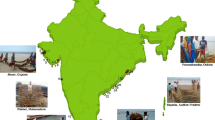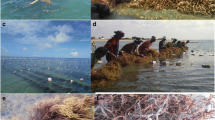Abstract
The Science & Society Division of Department of Science & Technology, Government of India sanctioned a project in 2005 under the Woman Scientist Program (DST WOS-B) with an objective to develop technologies for the cultivation of high-value seaweeds widely used for industrial purposes/human consumption with empowerment of the coastal communities in Kerala. The project was divided into two phases: an experimental/investigational phase and an extension phase. In the experimental phase, pilot-scale culture experiments were conducted to evaluate the possibility and feasibility of the cultivation of the red alga, Kappaphycus alvarezii, in the southwest coast of Kerala. Pilot-scale studies of seaweed culture were conducted in the shallow subtidal waters on the Vizhinjam Harbor area in two bamboo rafts tied with seeds of K. alvarezii (100 ± 1.20 g) following accepted culture and growth monitoring procedures. The first harvest was carried out after 45 days and the growth was nearly eight times the initial biomass (826 ± 2.80 g). A group of local fishermen were trained in the fabrication of culture rafts, implanting seed material, rearing the seedlings with periodical monitoring, harvesting, and post-harvest technologies like drying, sorting, packing, etc. as part of the pilot-scale study. The pilot-scale efforts showed good scope for the further expansion of the large-scale cultivation of K. alvarezii in the southwest coast of Kerala by imparting training and adopting fishermen families for their additional employment/alternative livelihood. Success in the pilot-scale cultivation led to the second phase of the project, the extension phase, which fulfilled the main objectives of the DST WOS-B programme. Vizhinjam Gramapanchayat (village), where the pilot-scale cultivation was carried out successfully and headed by a woman president, came forward to pool resources of the project to be implemented as a Model Seaweed Cultivation Programme. A training/workshop on “seaweed farming technology” was conducted and nearly 60 people were trained. Mangalam purusha sahaya sangham, a registered self-help group (SHG) of Vizhinjam, came forward to start the culture operations at Vizhinjam with technical backup from the DST-WOS-B Programme. Some seaweed entrepreneurs from inside and outside Kerala also came forward with a 100% buyback guarantee for the produce. Nationalised banks like the State Bank of India offered loans to trained SHGs for starting seaweed cultivation at commercial scale.

Similar content being viewed by others
References
Abhiram S (2006) Kappaphycus cultivation along Tamil Nadu coast. Abstracts, International Conference on Applied Phycology, Algae in Biotechnology and Environment, New Delhi, 9–10
Ask EI, Batibasaga A, Zertuche-González JA, de San M (2001) Three decades of Kappaphycus alvarezii (Rhodophyta) introduction to non-endemic locations. In: Chapman ARO, Anderson RJ, Vreeland VJ, Davison IR (eds) Proceedings, 17th International Seaweed Symposium, Cape Town, pp 49–57
Bindu MS (2006) Success in the pilot scale cultivation of Kappaphycus alvarezii in Vizhinjam bay, southwest coast of India. Training manual, National Training Workshop on Seaweed Farming and Processing for Food, the Thassim Beevi Abdul Kader College for Women, India, pp 54–60
Bindu MS (2007) Empowerment of coastal communities in cultivation of economically important seaweeds of Kerala. Project Report, Science & Society Division, Department of Science & Technology, Government of India, 25 pp
Bindu MS, Kumaraswamy Achary GP (2006) Experimental field cultivation of Kappaphycus alvarezii (Doty) Doty at Vizhinjam Bay, south west coast of Kerala. Abstracts, International Conference on Applied Phycology, Algae in Biotechnology and Environment, New Delhi, p 58
Bindu MS, Sobha V (2006) An appraisal of seaweed resource of Kerala coast. Abstracts, International Conference on Applied Phycology, Algae in Biotechnology and Environment, New Delhi, p 177
Bindu MS, Sobha V (2007) Pigment composition in seaweeds of Kerala and their potential application in immunodiagnostics. Proceedings, XIX Kerala Science Congress, Kerala State Council for Science, Technology and Environment 1, pp 625–627
Bindu MS, Sobha V, Bindhu VK (2006) Amino acid and elemental composition of certain marine algae from Kerala coast, India. Indian Hydrobiol 9(2):139–145
Bixler HJ, Porse H (2010) A decade of change in the seaweed hydrocolloids industry. J Appl Phycol. doi:10.1007/s10811-010-9529-3
CMFRI (1987) Seaweed research and utilization in India. CMFRI Bulletin 41, p 116
Dawes CJ, Lluisma TGC (1994) Laboratory and field growth studies of commercial strains of Eucheuma denticulatum and Kappaphycus alvarezii in the Philippines. J Appl Phycol 6:21–24
Doty MS (1985) Eucheuma alvarezii sp. Nov. (Gigartinales, Rhodophyta) from Malaysia. In: Abbott LA, Norris JH (eds) Taxonomy of economic seaweeds with reference to some Pacific and Caribbean species. California sea grant college program, La Jolla, California, pp 37–45
Eswaran K, Jha B (2006) Commercial cultivation of Kappaphycus alvarezii in India. Training manual, National Training Workshop on Seaweed Farming and Processing for Food, The Thassim Beevi Abdul Kader College for Women, Kilakarai, India, pp 40–46
Eswaran K, Ghosh PK, Mairh OP (2002) Experimental field cultivation of Kappaphycus alvarezii (Doty) Doty ex. P. Silva at Mandapam region. Seaweed Res Util 24(1):67–72
Kaliaperumal N, Kalimuthu S, Ramalingam JR (2004) Present status of seaweed exploitation and industry in India. Seaweed Res Util 26(1&2):47–53
Kaliaperumal N, Ramalingam JR, Sulochanan B (2008) Growth and production of carrageenophyte Kappaphycus alvarezii in pilot scale cultivation in the Gulf of Mannar and Palk Bay. Seaweed Res Util 30(1&2):57–66
Lirasan T, Twide P (1993) Farming Eucheuma in Zanzibar, Tanzania. Hydrobiologia 260(261):353–355
Mairh OP, Zodape, Tewari A, Rajyaguru (1995) Culture of marine red alga Kappaphycus striatum (Schmitz) Doty on the Saurashtra region, west coast of India. Indian J Mar Sci 24:24–31
Mollin J, Braud JPA (1993) Eucheuma (Solieriaceae, Rhodophyta) cultivation test on the south west coast of Madagascar. Hydrobiologia 260/261:373–378
Nair N B (1988) Algal resources of Kerala coast and their economic utilization. Technical Report, Department of Environment, Government of India, 63 pp
Ohno M, Largo DB, Ikumoto TS (1994) Growth rate, carrageenan yield and gel properties of culture of kappa carrageenan producing red alga Kappaphycus alvarezii (Doty) Doty in the subtropical waters of Shikoku, Japan. J Appl Phycol 6:1–5
Ohno M, Nang HQ, Hirase S (1996) Cultivation and carrageenan yield and quality of Kappaphycus alvarezii in the waters of Vietnam. J Appl Phycol 6:431–437
Reeta Jayasankar (2006) Open sea farming of Kappaphycus in India. Training Manual, National Training Workshop on Seaweed Farming and Processing for Food, The Thassim Beevi Abdul Kader College for Women, Kilakarai, pp 47–53
Sakthivel M (1999) Resource potential, present status & solutions to the problems of seaweed cultivation in India. Seaweed Res Util 21(1&2):15–19
Samonate GPB, Hyrado-Ponce AR, Caturao R (1993) Economic analysis of bottom line and raft monocline culture of Kappaphycus alvarezii var. tambalang in Western Vesayas, Philippines. Aquaculture 110:1–11
Sobha V, Bindu MS (2007) Phytochemical analysis of seaweeds of Kerala with special reference to pigments. Project Completion Report, Kerala State Council for Science, Technology & Environment, 64 pp
SubbaRao PV, Easwaran K, Ganesan M (2004a) Cultivation of agarophytes in India: retrospect, prospects and future strategies. Seaweed Res Util 26(Special Issue):181–184
SubbaRao PV, Vaibhav AM, Mukund CT (2004b) Field cultivation of Kappaphycus alvarezii (Doty) Doty on Okhamandal coast, Gujarat. Abstracts, Seaweeds—2004, National Symposium and Exposition, Cochin, pp 22–24
Trono GC (1992) Eucheuma and Kappaphucus: taxonomy and cultivations. Bull Mar Sci Fish 12:51–65
Trono GC, Ohno M (1989) Seasonality in the biomass production of Eucheuma strains in Northern Bohol, Philippines. In: Umezaki I (ed) Scientific survey of marine algae and their resources in the Philippine islands. Technical Report, Ministry of Education, Science and Culture, Japan, pp 71–80
Acknowledgments
MS Bindu is thankful to the Science & Society Division, Department of Science & Technology, Government of India, for the award of Woman Scientist Fellowship for the present study. The paper is dedicated to the group of young fishermen from the Vizhinjam coast whose enthusiasm and involvement is the key success of the development of a seaweed cultivation program in Kerala.
Author information
Authors and Affiliations
Corresponding author
Rights and permissions
About this article
Cite this article
Bindu, M.S. Empowerment of coastal communities in cultivation and processing of Kappaphycus alvarezii—a case study at Vizhinjam village, Kerala, India. J Appl Phycol 23, 157–163 (2011). https://doi.org/10.1007/s10811-010-9597-4
Received:
Revised:
Accepted:
Published:
Issue Date:
DOI: https://doi.org/10.1007/s10811-010-9597-4




